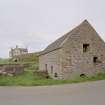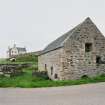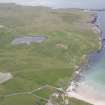Pricing Change
New pricing for orders of material from this site will come into place shortly. Charges for supply of digital images, digitisation on demand, prints and licensing will be altered.
Balnakeil Mill
Watermill (19th Century)
Site Name Balnakeil Mill
Classification Watermill (19th Century)
Alternative Name(s) Balnakeil, Corn Mill; Balnakeil, Former Corn Mill
Canmore ID 4814
Site Number NC36NE 51
NGR NC 39147 68565
Datum OSGB36 - NGR
Permalink http://canmore.org.uk/site/4814
- Council Highland
- Parish Durness
- Former Region Highland
- Former District Sutherland
- Former County Sutherland
NC36NE 51 39144 68570
For detached wheel-pit at NC 3918 6866, see NC36NE 17.01.
(Location cited AS NC 392 686). Corn mill, Balnakeil, early 19th century. A 2-storey rectangular rubble building, now gutted, with the site of a high-breast wheel about 3ft (0.9m) wide by 10ft (3.1m) diameter. By Balnakeil House (NC36NE 4) is a detached wheel-pit (NC36NE 17.01) for a wheel about 54ins (1.37M) wide by 10ft (3.1m) diameter, which powered a rope drive to the steading on the hillside above.
J R Hume 1977.
2-storey, rectangular-plan, gabled former water-powered grain mill situated on sloping site with man-made embankment to 1st-floor entrance at rear. Roughly coursed rubble with sandstone dressings. Long and short quoins and window margins. Principle elevation to NE with central door and window to right. Entrance doorway with piended roof breaking eaves to rear (SW) elevation. Irregular fenestration to gables; opening for water wheel shaft at lower ground floor to SW gable; small opening above right and further central opening at 1st floor. Ashlar-coped skews. Graded grey Scottish slate. Flue aperture in ridge to N for kiln.
Balnakeil mill is a rare surviving example of an early 19th century water powered threshing mill with kiln retaining much of its former context as well as a considerable amount of interior fabric. The building is located to the immediate S of Balnakeil House and, along with the remains of the Durness Old Parish Church and Burial Ground (see separate listing), contributes greatly to the wider landscape setting of the group as a whole.
The survival of its associated lade and its relation to the nearby listed Balnakeil House provide further interest. The corn mill was powered by water from Loch Croispol which is situated to the S of the mill. A sluice at the northern tip of the loch controlled the water from the loch into the mill lade. The lade runs along the E of the mill and a further sluice to the S fed water into the wheelpit. The high breast-shot water wheel was attached to the S elevation. The water from the wheel pit ran into an underground tail race to meet the stream which runs to the W of the mill. The lade continues from the mill towards Balnakeil House where the water drove a second water wheel. This wheel powered a threshing mill rope drive, the remains of which are situated about 100m E of the wheel. The mill was last used at sometime between 1911 and 1914, at which time it was principaly used for grinding meal.
Balnakeil sits on limestone rock, giving rise to highly fertile soil, unusual in the NW highlands. A mill on the site is shown on Timothy Pont´s map of 1590-1600. However, the present building was constructed c.1830 following the acquisition of the Reay Estate from Lord MacKay by the Duke of Sutherland.
Balnakeil House is a mid 18th century country house (listed at category A) built on the site of the summer residence of the Bishops of Sutherland and Caithness and formerly used as an occasional residence of the Lords of Reay.
This list description was updated and the category changed from C(S) to B in 2007. (Historic Scotland)






















































